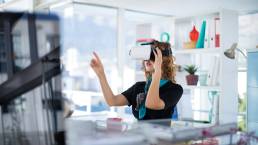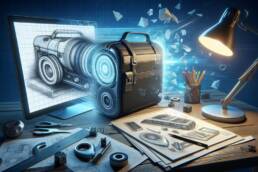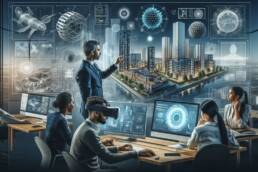In our digital age, two technologies stand out for transforming how we see and interact with products: Virtual Reality (VR) and Augmented Reality (AR). These aren’t just new tools; they’re revolutionizing business-consumer interactions, making experiences more interactive, immersive, and focused on what customers need. Let’s explore how VR and AR are reshaping product visualization.
Virtual Reality (VR) is reshaping the way we visualize products, offering an immersive experience that traditional photography or videography simply cannot match. This technology allows customers to explore products in a virtual space, providing a sense of depth, scale, and detail that feels as close to reality as possible without physically interacting with the product. Let’s delve deeper into how VR is creating immersive experiences and transforming industry standards.

1. Immersive Experiences with VR:
VR technology has the unique ability to transport users into a fully realized 3D environment. For product visualization, this means customers can explore every aspect of a product, from its design and functionality to its aesthetic appeal, in a way that feels tangible. For example, in the automotive industry, VR enables potential buyers to sit in the driver’s seat of a car, inspect its interior, and even simulate the driving experience, all from the comfort of their home. This level of immersion not only enhances customer engagement but also enables a deeper understanding of the product, facilitating more informed purchasing decisions.
The real estate sector provides another compelling application of VR. Traditional property viewing methods are limited by geographical and time constraints. VR overcomes these limitations by offering virtual tours of properties. Prospective buyers can navigate through every room of a house, inspecting details such as the finishes, fixtures, and spatial layouts, without ever setting foot on the property. This accessibility is particularly beneficial for international or out-of-state buyers, making the market more inclusive and expanding the customer base for sellers.
2. VR in Industry: Transforming Traditional Visualization:
The impact of VR on product visualization extends beyond individual consumer experiences, influencing entire industries to rethink their presentation and marketing strategies.
- Real Estate: As mentioned, VR tours have revolutionized property viewings. Real estate agents now use VR to enhance their listings, providing a 24/7 open house that can reach potential buyers worldwide. This not only speeds up the buying process but also reduces the time and costs associated with physical viewings.
- Automotive: Car manufacturers are using VR to offer virtual showrooms. Customers can customize their vehicle — from color to features — and see the results in real-time. This level of customization and exploration was unimaginable with traditional visualization techniques.
- Education and Training: Beyond product visualization, VR is transforming how educational content and training programs are delivered. For example, medical students can perform virtual surgeries, offering a hands-on learning experience without the risks associated with real-life operations.
- Retail: VR technology allows customers to try products virtually, whether it’s trying on clothes, testing furniture in a virtual home layout, or previewing how a new gadget will fit into their lives. This application is particularly useful in reducing the uncertainty associated with online shopping, potentially decreasing return rates and increasing customer satisfaction.
3. Challenges and Opportunities:
While VR presents numerous opportunities for enhancing product visualization, it also faces challenges. High costs of VR equipment and the need for technical know-how can be barriers to widespread adoption. However, as technology advances and becomes more accessible, these challenges are gradually being overcome. The future of VR in product visualization looks promising, with ongoing innovations aimed at improving user experience, reducing costs, and further integrating VR into mainstream commerce and education.
AR: Augmented Reality’s Role in Enhancing Product Visualization
Augmented Reality (AR) is like adding magic to the real world. It mixes digital images and information with the environment around you, showing on your phone or AR glasses as if they were actually there. This technology is especially useful when shopping, as it helps you visualize how products would look in real life, in your own space. Let’s dive into how AR is making shopping more fun and realistic and take a look at some real-life examples.

1. Practical Applications of AR in Product Visualization:
Imagine you’re shopping for a new sofa but aren’t sure how it will look in your living room. With AR, you can see the sofa in your room through your phone’s screen before you buy it. This helps you decide if it fits well with your other furniture and if the color matches your room’s style. It’s not just furniture; you can also see how clothes would look on you without trying them on, or how a new shade of paint would change your room’s vibe. AR makes shopping easier because you can try things out virtually, saving time and reducing the guesswork.
2. Case Studies: AR’s Impact on Retail and Beyond:
- IKEA’s AR App: IKEA has an app that lets you place furniture in your room virtually. You can move it around, see if it fits, and check if the style matches your home. This is super helpful because you can make sure you’re happy with how it looks before you make a purchase.
- Car Shopping with AR: Some car companies use AR to let you see how a new car would look parked in your driveway. You can even customize the car’s color and wheels, making it easier to imagine how the car fits into your life.
- Trying On Clothes Virtually: Some clothing stores have AR apps that let you see how clothes would look on you without having to change. You can mix and match different pieces to see how they go together, making shopping for the perfect outfit a lot more fun.
- Decorating Your Home: There are AR apps for home improvement, too. You can see how different wall colors would look in your rooms or how new light fixtures would change the ambiance. This is great for planning renovations without having to buy samples of everything.
3. Why AR is So Cool:
AR blends the digital and real worlds, making it easier to visualize how products fit into your life. It’s like having a superpower that lets you see the future of your space or how you’ll look in a new outfit. Plus, it’s just really fun to use. As more people try AR, companies are finding new and exciting ways to use it, making shopping not just easier but also a lot more enjoyable.
The Technology Behind VR and AR in Product Visualization
1. Understanding VR and AR Technologies:
At the core of VR and AR are three main ingredients: super-smart computers, design that puts us first, and software that knows how to make everything interact. VR takes you into a completely digital world. Once you put on a VR headset, it’s like stepping into a new place where you can look around, move, and interact with things as if you were really there. AR, on the other hand, uses devices like smartphones or AR glasses to overlay digital images onto the real world around you. So, you might see a virtual TV on your wall through your phone’s screen to decide if it’s the right size before you buy it.
2. Innovations and Developments in VR and AR Technology:
Thanks to some really smart people working on making VR and AR better, these technologies have grown a lot. VR headsets are becoming more comfortable to wear, with better screens that make the virtual worlds look super sharp and real. They’re also working on making these headsets work without wires, so you can explore without tripping over cables.
AR is also getting some cool upgrades. Smartphones are getting better at understanding the space around you, making it easier for AR apps to place virtual objects in the real world in a way that looks natural. Plus, there are new AR glasses being developed that look more like regular glasses, so in the future, you might use AR just as easily as you wear your sunglasses.
Both VR and AR are becoming more accessible, meaning more people can use them. Whether it’s for fun, like playing games or exploring new places, or for practical stuff, like shopping and learning, these technologies are making our digital experiences more immersive and interactive.
3. Why This Matters:
The magic of VR and AR in product visualization is not just about seeing things in 3D. It’s about making the experience of shopping and learning more engaging and helpful. As these technologies keep getting better, we’re going to see even more amazing ways to use them. From trying on clothes without going to the store to decorating your home with virtual furniture, the possibilities are endless. The future of VR and AR is super exciting, and it’s going to change the way we interact with the world around us in some pretty cool ways.
Overcoming Challenges: The Road Ahead for VR and AR in Product Visualization
Even though Virtual Reality (VR) and Augmented Reality (AR) are super cool technologies that can change the way we shop and learn, they’re not perfect. There are a few bumps in the road we need to smooth out. But don’t worry, smart people are working on it, and the future looks bright. Let’s dive into what’s being done to tackle these challenges and what we can look forward to.
1. Addressing Technical and User Experience Challenges:
One of the biggest hurdles for VR and AR is that they require special gadgets, like headsets for VR or the latest smartphones for AR. Not everyone has these, which can make it hard for everyone to jump into these awesome experiences. Plus, getting used to these technologies can take a little time, especially if you’re not a tech whiz.
To make VR and AR more user-friendly, designers and tech experts are focusing on making the gadgets lighter, more comfortable, and easier to use. They’re also working on making VR and AR work with devices most of us already have, like making AR apps that run smoothly on more types of smartphones.
Another challenge is making sure everyone can enjoy VR and AR without feeling dizzy or uncomfortable. This means improving how smoothly and realistically these technologies can mimic real-life movements and interactions. The better they get at this, the more fun and useful they’ll be for everyone.
2. Future Prospects: Evolving VR and AR for Enhanced Product Visualization:
Imagine a future where shopping with VR and AR is as common as using your phone to take pictures. That’s where we’re headed. VR and AR are going to become more integrated with other cool techs, like artificial intelligence (AI) and the Internet of Things (IoT). This could mean having a personal shopping assistant in your VR world that knows exactly what you like or seeing how a new coffee maker would look on your counter through AR, all tailored just for you.
The possibilities are endless. You might be able to customize products in VR and AR, seeing exactly how your choices change the look or function of a product in real-time. Or you could have an AR guide help you fix your bike or cook a complicated recipe, step by step, right in your kitchen.
As VR and AR get better at understanding our world and us, the experiences they offer will become even more personalized and engaging. This isn’t just great for shopping; it could change how we learn, work, and play. The key to getting there is to keep improving the technology, making it more accessible and enjoyable for everyone.
3. Wrapping Up:
VR and AR have some challenges to overcome, but the future is bright. With ongoing improvements and exciting possibilities on the horizon, these technologies are set to make our interactions with products and the world around us more immersive and personalized than ever before. So, keep an eye out; the next big thing in VR and AR might be just around the corner, ready to change the way we see and interact with the world.
Get your project estimated within 60 minutes - simply send us your project brief!
Conclusion: The Transformative Role of VR and AR in Product Visualization
Virtual and Augmented Reality are reshaping product visualization, offering new ways to engage with and understand products. As these technologies continue to develop, their impact on how we view and interact with products will only increase, heralding a new era in the digital consumer experience.
This exploration into VR and AR simplifies the complex world of product visualization, making it accessible to everyone. It’s a glimpse into a future where our digital and physical worlds blend seamlessly, enhancing how we shop, learn, and experience the world around us. For businesses and consumers alike, it’s a thrilling journey just beginning.



